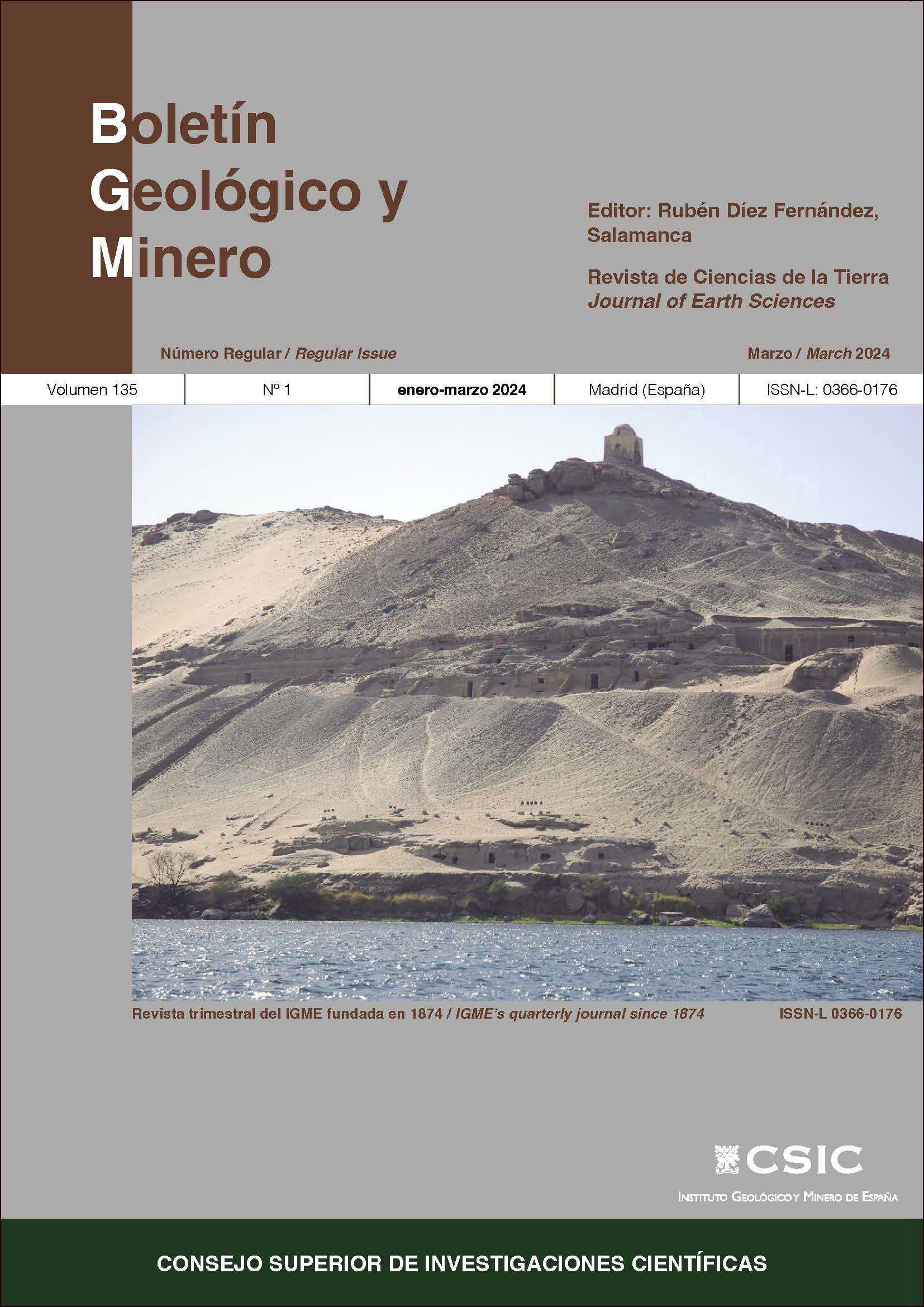Statistical Evaluation of the classification-milling loop of the carbon in pulp plant of Antapite of the Company Sierra Sun Group (Peru) using regression analysis and ANOVA
DOI:
https://doi.org/10.21701/bolgeomin/135.1/002Keywords:
Gold, Metallurgy, Mining, Carbon in pulpAbstract
This manuscript involved a statistical evaluation of the milling-classification loop of the Antapite gold plant in Perú. The current metallurgical process is based on the carbon in pulp, which treats a head gold grade ore of 29.5 g/t. Nowadays, the milling loop uses a ball mill, whose discharged ore feeds a conventional Krebs hydrocyclone. Under current operating conditions, 71.30% of the gold concentrate is <74 μm (of 10 inches). Nevertheless, the objective was to increase at least 5 points in percentage the gold content in the concentrate to optimize the gold recovery in the cycyanidation-adsorption loop. This objective was solved by means of a multivariate statistics regression model to study the dependency of the variables in three different scenarios, eliminating
the non-significative statistical variables. The first scenario included the dependence of the cut size, d50C, with respect to the pressure and the feeding flow to the hydrocyclone. The second scenario involved the analysis of the dependence of the gold concentrate <74 μm with respect to the feeding flow, pressure, d50 and d50C. Finally, the third scenario included the evaluation of the gold concentrate <74 μm and d50C. Later, and once defined the parameter that would have influenced the variable of the gold concentrate <74 μm with the studied variables, it was possible to find the value of d50 correlated with the flow and working pressure to obtain the objective cut size of 77.39% of gold concentrate with < 74 μm.
Downloads
References
Baeza, D., Navarro, F., and Townley, B. (2016). Applying data science techniques to metallurgical characterization [Oral presentation]. GEOMET 2016 - 3rd International Seminar on Geometallurgy, Lima, Perú.
Chen, W., Nathalie Zydek, N., and Parma, F. (2000). Evaluation of hydrocyclones models for practical applications. Chemical Engineering Journal, 80, 295-303. https://doi.org/10.1016/S1383-5866(00)00105-2
Cho, K., Kim, H., Myung, E., Purev, O., Choi, N., and Park, C. (2020). Recovery of gold from the refractory gold concentrate using microwave assisted leaching. Metals, 10, 571. https://doi.org/10.3390/met10050571
Fernández-González, D., Martín-Duarte, R., Ruiz-Bustinza, I., Mochón, J., González-Gasca, C., and Verdeja, L. F. (2016). Optimization of sinter plant operating conditions using advanced multivariate statistics: Intelligent data processing. JOM, 68, 2089-2095. https://doi.org/10.1007/s11837-016-2002-2
Galvin, K. P., and Iveson, S. M. (2022). New challenges for gravity concentration and classification of fine particles. Minerals Engineering, 190, 107888. https://doi.org/10.1016/j.mineng.2022.107888
Gu, H., Ma, F., Guo, J., Li, K., and Lu, R. (2017). Hydrochemistry, multidimensional statistics, and rock mechanics investigations for Sanshandao Gold Mine, China. Arabian Journal of Geosciences, 10, 62. https://doi.org/10.1007/s12517-017-2841-3
Handley, J. A., de Lange, M. F., Essrich, J. A. J., and Banning, F. (2000). A review of the sequential grid mining method employed at Elandsrand Gold Mine. Journal of the Southern African Institute of Mining and Metallurgy, 100(3), 157-168.
Jooshaki, M., Nad, A., and Michaux, S. (2021). A systematic review on the application of machine learning in exploiting mineralogical data in mining and mineral industry. Minerals, 11(8), 816. https://doi.org/10.3390/min11080816
Krige, D. G. (1970). The role of mathematical statistics in improved ore valuation techniques in South African gold mines. In M.A. Romanova, and O.V. Sarmanov (Eds.), Topics in Mathematical Geology (pp. 243-261). Springer. https://doi.org/10.1007/978-1-4899-2708-8_22
Lee, W., Jung, M., Han, S., Park, S., and Park J.-K. (2020). Simulation of Layout rearrangement in the grinding/classification process for increasing throughput of industrial gold ore plant. Minerals Engineering, 157, 106545. https://doi.org/10.1016/j.mineng.2020.106545
Li, Q., Zhang, Y., Liu, X., Xu, B., Yang, Y., and Jiang, T. (2017). Improvement of gold leaching from a refractory gold concentrate calcine by separate pretreatment of coarse and fine size fractions. Minerals, 7(5), 80. https://doi.org/10.3390/min7050080
Rao, P. D., Wolff, E. N., and Maneval, D. R. (1982). Application of Hydrocyclones for recovery of Fine Gold from Placer material. Mineral Industry Research Laboratory School of Mineral Industry, University of Alaska, Fairbanks, Alaska 99701.
Taylor, D. L., and Altman, K. A. (2001). Geological data analysis for mineral processing: Dragging metallurgy into the twenty-first century. In: X. Heping (Ed.), Computer Applications in the Mineral Industries. CRC Press.
Turan, M. D. (2018). Statistical approach to mineral engineering and optimization. In A.I. Al-Juboury, Contributions to Mineralization (Chapter 8). Intechopen. https://doi.org/10.5772/intechopen.71607
Published
How to Cite
Issue
Section
License
Copyright (c) 2024 Consejo Superior de Investigaciones Científicas (CSIC)

This work is licensed under a Creative Commons Attribution 4.0 International License.
© CSIC. Manuscripts published in both the print and online versions of this journal are the property of the Consejo Superior de Investigaciones Científicas, and quoting this source is a requirement for any partial or full reproduction.
All contents of this electronic edition, except where otherwise noted, are distributed under a Creative Commons Attribution 4.0 International (CC BY 4.0) licence. You may read the basic information and the legal text of the licence. The indication of the CC BY 4.0 licence must be expressly stated in this way when necessary.
Self-archiving in repositories, personal webpages or similar, of any version other than the final version of the work produced by the publisher, is not allowed.















